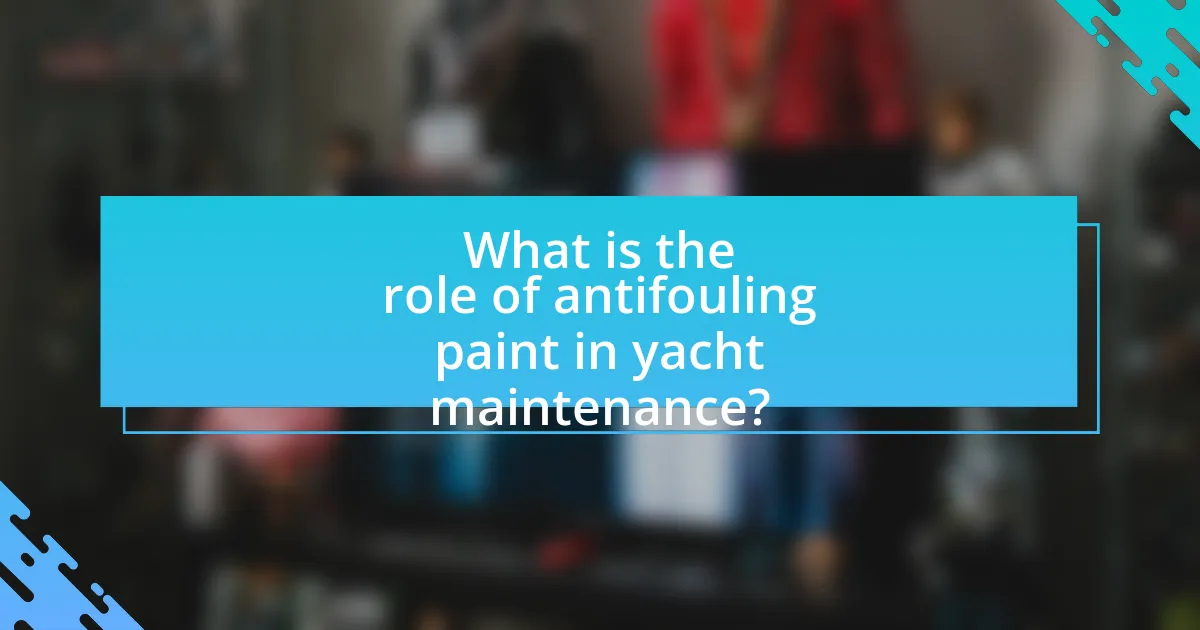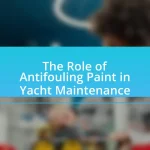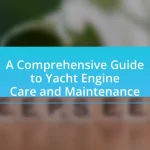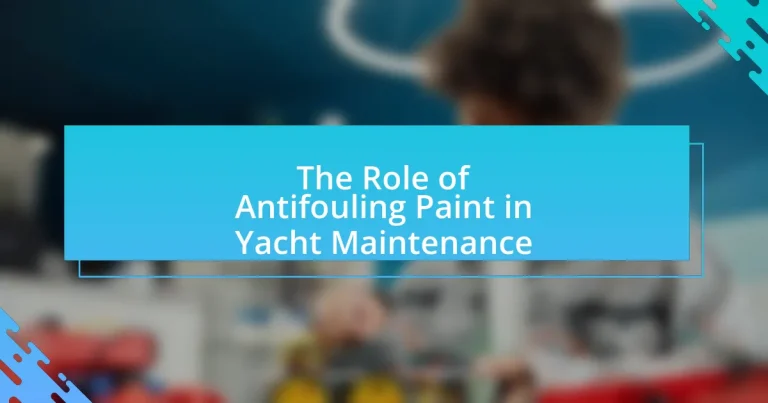Antifouling paint is a vital component of yacht maintenance, designed to prevent the growth of marine organisms on the hull, which can significantly impact performance and fuel efficiency. This article explores the mechanisms by which antifouling paint protects yachts, the types of marine organisms it deters, and the chemical processes involved in its effectiveness. It also discusses the importance of regular application, the different types of antifouling paints available, and best practices for application and maintenance. Additionally, the article addresses common issues yacht owners may encounter with antifouling paint and how to troubleshoot them effectively.

What is the role of antifouling paint in yacht maintenance?
Antifouling paint plays a crucial role in yacht maintenance by preventing the growth of marine organisms on the hull. This protective coating reduces drag, enhances fuel efficiency, and prolongs the lifespan of the vessel. According to the International Maritime Organization, fouling can increase fuel consumption by up to 40%, making antifouling paint essential for maintaining optimal performance and reducing operational costs.
How does antifouling paint protect yachts?
Antifouling paint protects yachts by creating a surface that prevents the growth of marine organisms such as barnacles, algae, and mussels. This specialized paint contains biocides that leach into the water, deterring these organisms from adhering to the hull. The effectiveness of antifouling paint is supported by studies showing that vessels with antifouling coatings experience reduced drag and improved fuel efficiency, as fouling can increase resistance in the water. Additionally, regular maintenance with antifouling paint can extend the lifespan of a yacht’s hull by preventing damage caused by marine growth.
What types of marine organisms does antifouling paint prevent?
Antifouling paint prevents the growth of various marine organisms, including barnacles, algae, and mollusks. These organisms can attach to the hull of a yacht, leading to increased drag and reduced performance. Studies have shown that antifouling coatings effectively inhibit the settlement of these organisms by releasing biocides or creating surfaces that are difficult for them to adhere to. For example, research indicates that antifouling paints can reduce barnacle settlement by up to 90%, demonstrating their effectiveness in maintaining yacht performance and longevity.
How does antifouling paint work chemically to inhibit growth?
Antifouling paint works chemically by releasing biocides that prevent the growth of marine organisms on submerged surfaces. These biocides, such as copper compounds or organic biocides, disrupt the cellular processes of algae, barnacles, and other fouling organisms, inhibiting their ability to attach and grow. For instance, copper ions interfere with the metabolism of these organisms, leading to their death or detachment from the surface. This mechanism has been validated by studies showing that vessels coated with antifouling paint experience significantly less biofouling compared to uncoated vessels, thereby enhancing performance and reducing maintenance costs.
Why is antifouling paint essential for yacht performance?
Antifouling paint is essential for yacht performance because it prevents the growth of marine organisms on the hull, which can significantly hinder speed and fuel efficiency. When a yacht’s hull is fouled by barnacles, algae, or other marine life, it creates drag, leading to increased resistance in the water. This increased resistance can reduce a yacht’s speed by up to 10% and increase fuel consumption by as much as 30%, according to studies conducted by the International Maritime Organization. By using antifouling paint, yacht owners can maintain optimal performance, reduce maintenance costs, and enhance the longevity of the vessel.
How does fouling affect yacht speed and fuel efficiency?
Fouling significantly reduces yacht speed and fuel efficiency by increasing hydrodynamic drag. When marine organisms such as barnacles and algae attach to the hull, they create rough surfaces that disrupt water flow, leading to resistance. Studies indicate that even a small amount of fouling can decrease speed by up to 10% and increase fuel consumption by 20% or more, as the engine must work harder to maintain the same speed. This relationship underscores the importance of regular maintenance and the application of antifouling paint to mitigate these effects.
What are the long-term effects of neglecting antifouling paint?
Neglecting antifouling paint leads to significant long-term effects, including increased hull fouling, reduced vessel speed, and higher fuel consumption. Over time, marine organisms such as barnacles and algae accumulate on the hull, which can cause drag and impede performance. Studies indicate that a fouled hull can increase fuel consumption by up to 40%, resulting in higher operational costs. Additionally, the structural integrity of the yacht may be compromised due to corrosion and damage caused by prolonged exposure to marine growth. Regular maintenance of antifouling paint is essential to prevent these detrimental effects and ensure optimal performance and longevity of the vessel.
What are the different types of antifouling paints available?
The different types of antifouling paints available include hard antifouling paints, soft antifouling paints, and hybrid antifouling paints. Hard antifouling paints, which contain biocides, provide a durable surface that resists wear and can be polished for speed. Soft antifouling paints release biocides gradually and are designed to erode over time, making them suitable for slower vessels. Hybrid antifouling paints combine features of both hard and soft types, offering flexibility in performance. These classifications are based on their composition and intended use, ensuring effective prevention of marine growth on vessels.
What are the key differences between hard and soft antifouling paints?
Hard antifouling paints release biocides at a controlled rate and are designed to create a durable, smooth surface that resists fouling organisms. In contrast, soft antifouling paints are designed to erode over time, releasing biocides continuously and providing a softer surface that can be less effective in high-speed applications. Hard paints typically last longer and are more suitable for boats that remain in the water for extended periods, while soft paints are often preferred for vessels that are frequently hauled out or used in varying conditions. The effectiveness of hard antifouling paints is supported by their ability to maintain a clean hull over longer periods, while soft antifouling paints are validated by their adaptability to changing marine environments.
How do biocide-based and non-biocide antifouling paints compare?
Biocide-based antifouling paints contain active chemical agents that prevent the growth of marine organisms, while non-biocide antifouling paints utilize physical properties or alternative methods to deter fouling without harmful chemicals. Biocide-based paints are effective in controlling a wide range of fouling species, as evidenced by their long-standing use in marine applications, but they raise environmental concerns due to potential toxicity to marine life. In contrast, non-biocide options, such as silicone or foul-release coatings, are considered more environmentally friendly and can be effective in specific conditions, although they may not provide the same level of protection in heavily fouled environments. Studies have shown that while biocide-based paints can offer immediate and robust antifouling performance, non-biocide alternatives are gaining traction for their sustainability and reduced ecological impact.
How often should antifouling paint be applied?
Antifouling paint should be applied every one to two years, depending on the type of paint used and environmental conditions. Regular maintenance is essential because antifouling paint deteriorates over time due to exposure to water, sunlight, and marine organisms. For instance, hard antifouling paints may last longer, while soft paints might require more frequent applications. According to the International Council of Marine Industry Associations, proper application and timely reapplication can significantly enhance a yacht’s performance and longevity.
What factors influence the frequency of antifouling paint application?
The frequency of antifouling paint application is influenced by factors such as water temperature, type of vessel usage, and the specific antifouling paint formulation. Warmer water temperatures accelerate the growth of marine organisms, necessitating more frequent applications. Additionally, vessels that are used more often or are kept in high-fouling areas require more regular maintenance. The formulation of the antifouling paint also plays a critical role; some paints are designed for longer-lasting protection, while others may need to be reapplied more frequently based on their active ingredients and effectiveness against specific fouling organisms.
How can yacht owners determine the right timing for reapplication?
Yacht owners can determine the right timing for reapplication of antifouling paint by regularly inspecting the hull for signs of fouling and wear. Typically, reapplication is recommended every one to three years, depending on the type of antifouling paint used and environmental conditions. For instance, if a yacht is frequently used in warm, nutrient-rich waters, it may require more frequent reapplication due to accelerated growth of marine organisms. Additionally, if the paint appears to be peeling or losing its effectiveness, this indicates that reapplication is necessary. Regular maintenance checks and monitoring of performance can help yacht owners make informed decisions about the timing for reapplication.
What are the best practices for applying antifouling paint?
The best practices for applying antifouling paint include thorough surface preparation, selecting the appropriate type of antifouling paint, applying in suitable weather conditions, and ensuring proper application techniques. Surface preparation involves cleaning and sanding the hull to remove old paint and contaminants, which enhances adhesion. Choosing the right antifouling paint is crucial; options vary based on water conditions and boat usage, such as hard or soft paints. Application should occur in dry, mild weather to ensure optimal curing, and using a roller or brush can help achieve an even coat. These practices are supported by industry standards, which emphasize that proper preparation and application significantly improve the longevity and effectiveness of antifouling coatings.
How should the surface be prepared before applying antifouling paint?
The surface should be thoroughly cleaned and sanded before applying antifouling paint. This preparation involves removing any existing paint, dirt, grease, and marine growth using a pressure washer or scrubbing with appropriate solvents. Sanding the surface creates a rough texture that enhances adhesion, ensuring the antifouling paint bonds effectively. According to the International Maritime Organization, proper surface preparation is crucial for the longevity and effectiveness of antifouling coatings, as it minimizes the risk of peeling and enhances performance against marine organisms.
What safety precautions should be taken during application?
During the application of antifouling paint, it is essential to wear appropriate personal protective equipment (PPE), including gloves, goggles, and a respirator, to prevent skin contact and inhalation of harmful fumes. The use of PPE is critical because antifouling paints often contain toxic substances that can pose health risks. Additionally, ensure proper ventilation in the application area to disperse any volatile organic compounds (VOCs) released during the process. This is supported by safety guidelines from organizations such as the Occupational Safety and Health Administration (OSHA), which emphasize the importance of minimizing exposure to hazardous materials. Furthermore, it is advisable to follow the manufacturer’s instructions regarding application methods and drying times to ensure safety and effectiveness.
How can yacht owners troubleshoot antifouling paint issues?
Yacht owners can troubleshoot antifouling paint issues by conducting a thorough inspection of the hull for signs of peeling, blistering, or ineffective fouling prevention. Identifying the specific problem, such as inadequate application or compatibility with the underlying surface, is crucial. For instance, if the paint is peeling, it may indicate improper surface preparation or application conditions, which can be verified by checking the manufacturer’s guidelines for the specific antifouling product used. Additionally, owners should assess the water conditions where the yacht is moored, as different environments can affect paint performance. Regular maintenance checks and following the recommended reapplication schedule can also help mitigate issues, as studies show that antifouling effectiveness diminishes over time.
What signs indicate that antifouling paint is failing?
Signs that antifouling paint is failing include visible growth of marine organisms, such as barnacles and algae, on the hull, which indicates that the paint is no longer effectively preventing fouling. Additionally, peeling or flaking of the paint surface suggests that the bond between the paint and the substrate is compromised, reducing its protective capabilities. Another sign is the presence of discoloration or chalking, which can indicate degradation of the paint’s active ingredients. These indicators are critical for yacht maintenance, as failing antifouling paint can lead to increased drag, reduced performance, and potential damage to the hull.
How can yacht owners address common antifouling paint problems?
Yacht owners can address common antifouling paint problems by regularly inspecting the hull for signs of wear, such as peeling or blistering, and by ensuring proper application techniques during repainting. Regular inspections help identify issues early, allowing for timely maintenance, while proper application techniques, including surface preparation and adherence to manufacturer guidelines, ensure optimal performance of the antifouling paint. Studies indicate that improper application can lead to a 30% reduction in effectiveness, emphasizing the importance of following best practices in maintenance.















